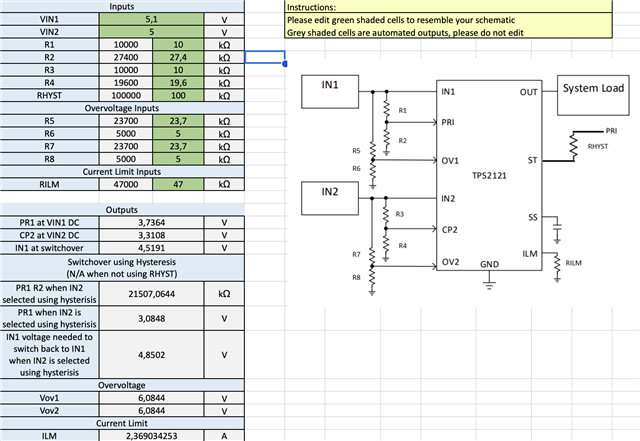Tool/software:
Hi All
I'm using the TPS2121 to switch among 2 inputs:
IN1 : 5.1V from TPS562242DRLR, Output capacitors 100uF + 22uF
IN2 : USB connector 4.8 to 5.2V, Output capacitors 10uF + 4.7uF (recommended 10uF from USB spec)
OUT : Output capacitors 100uF + 100uF + 47uF
I do not want the board to reboot when switching from one input to the other.
Current is about 1.2 Amp max, priority to IN1 (DC connector to TPS562242DRLR).
I'm using the following values for the TPS2121 :
Depending on the USB cable length, USB adapter quality, I sometimes observe the TPS2121 cycling between IN1 and IN2, sometimes it stops after the voltages on IN1 / IN2 are stables, sometimes it reboots the board.
I reduced Rhyst to 100K, that helps, but did not completely solve the issue.
I noticed one thing on IN1 :
When I disconnect the DC cable providing power to IN1, the TPS562242D becomes disabled and the voltage at IN1 starts decreasing, but with 122uF, the voltage decreases slowly and TPS2121 cycles between IN1 and IN2 until PR1 becomes lower than CP2.
I added a 820R - 0805 resistor in parallel to the 122uF at IN1, to allow a "fast" discharge path so IN1 voltage decreases faster, it seems to solve my issue and the TPS2121 no longer cycles between IN1 and IN2.
820R results in about 6mA extra current on the TPS562242D and allows PR1 to become lower than CP2 in about 2ms.
I was wondering if you see any side effect or potential issue when adding this 820R resistor in parallel to IN1 capacitors ?
I see a lot of messages mentioning this similar issue on this forum and the answers are always : Increase input capacitance or use larger hysteresis, I never read a TI answer mentioning to discharge capacitors faster to minimize the phenomena.
Thanks for your feedback about this way to solve this issue.
Jerome

